Techniques for assembling and disassembling laptops for repair using the example of the Toshiba Portege M800
In this topic, I would like to share my thoughts on the repair assembly and disassembly of laptops, since a small and modest experience has accumulated. It will be about the captured and commented on process of assembling a Toshiba Portege M800 laptop. The idea of imprinting in the pictures came after after the laptop was pulled, so the picture is represented by the assembly. In addition, I hope the article will be useful for repairing this device. The main important points found in the topic are gathered together at the end.
Caution, traffic (24 photos).
First, I want to note that any practical use of this article is entirely at your own peril and risk!Remember, it’s better to ask or google (and sometimes just think longer) than try to do something that you don’t understand.
It was necessary to disassemble the laptop in order to find a place of bad contact in the power circuit. To do this, a wire harness with a connector for connecting an adapter that goes to the motherboard was extracted (for studying, pinching contacts and, if necessary, soldering in a problem place) It is difficult to name a component, for the sake of which it would be necessary to disassemble the laptop in more detail:
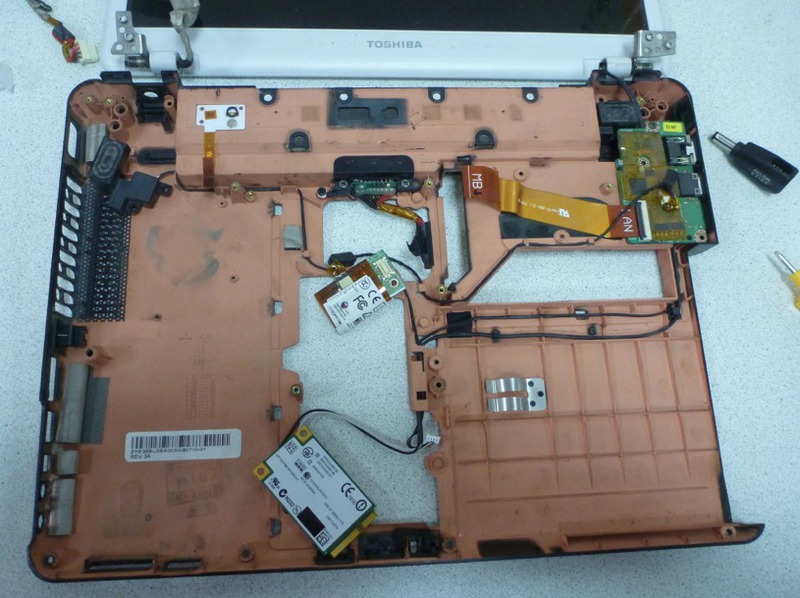

For this repair, we need a Philips screwdriver (Phillips screwdriver) (carefully select the size of the screws) and a wooden or plastic strip, which is not a pity to periodically grind to the state of a chisel. A good option is a disposable Chinese chopstick. It will be almost a consumable.
When disassembling, I recommend the use of small lockable containers for screws with signatures, which clearly allow you to restore their purpose and location during assembly. Locked, because it is likely that after disassembling something will distract from the process, and it will be necessary to assemble and pack the disassembled device untilbetter assembly times , and also so as not to scatter the cogs around the entire area with some kind of local cataclysm. Anything that is at hand will do. This time, Eppendorf's plastic tubes (eppendorfs) were on hand:

First of all, install the connector in the case and carefully lay the wiring harness as shown in the photo. Incorrectly inserting the connector itself is almost impossible - its shape is quite unique. After installation, we fix the screw grounding to the case with an orange conductive coating.
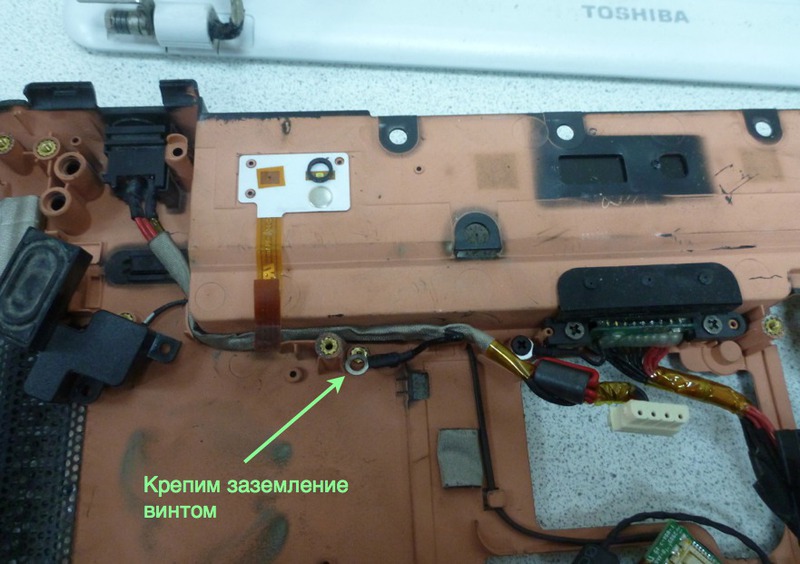
Now we put in place the left speaker and fasten it with two carefully kept screws.
The screws must be tightened to a reasonable point. Too tightly done, “forever” is not worth it - you can spoil the aesthetics of the screw slot, as well as deform the plastic. In addition, this will make thenext possible disassembly difficult .
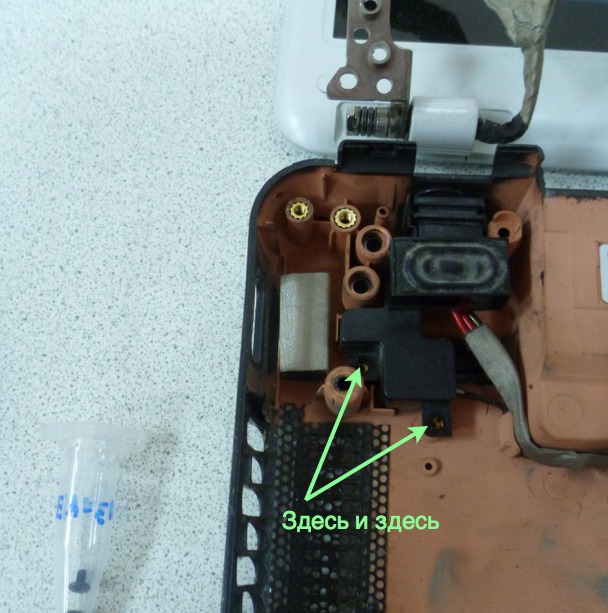
We pass to the right loop of the monitor. Carefully lay the wire of the Wi-Fi antenna into the depths to the right of the right speaker, put the loops of the monitor in place and fix them with the corresponding screws.
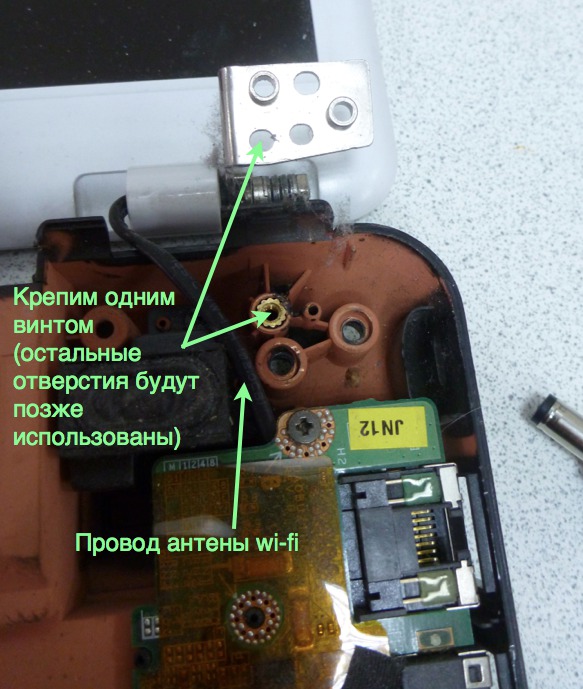
The hinges are usually quite tight, so it’s best to straighten both at once and screw them together, putting the monitor body in the most convenient position.
Types of motherboard bottom and top, respectively:
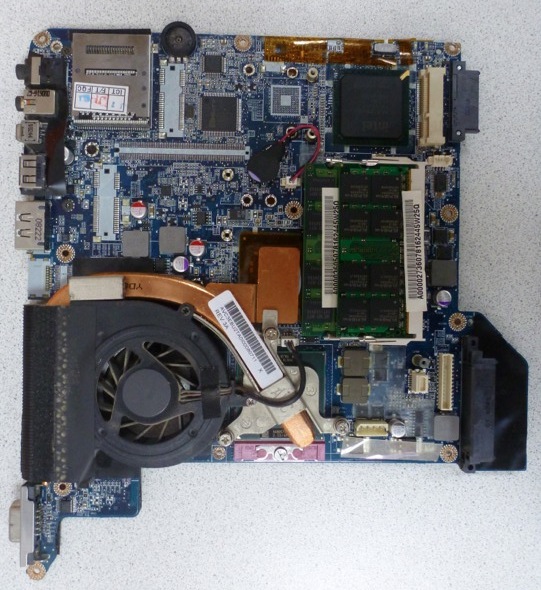
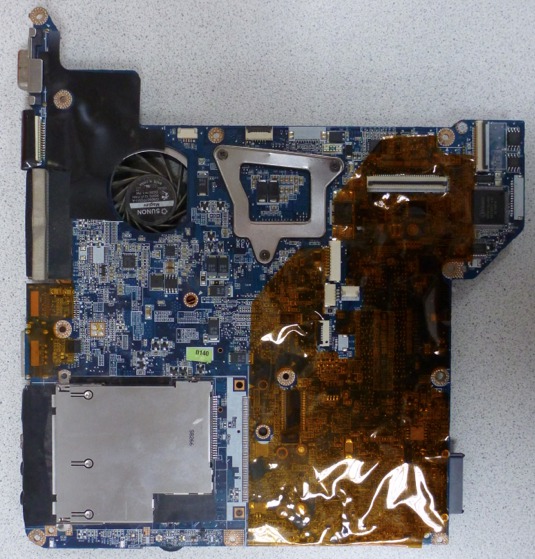
When working with circuit boards, it is extremely important to exercise caution with static electricity. Regularly align your potential and the potential of the earth on the board (by touching the metal case of the connector on the side of the board, for example). This is especially true when using woolen clothing and / or concentrated fidgeting on a chair, without which it will be difficult to do. Ideally, it is good to use an antistatic bracelet.
We install the motherboard in its place (it is also quite difficult to put it wrong). Do not forget to be careful when its connectors or other parts abut against the laptop case. If excessive force is applied, the contact of these parts with the board may break. Not useful board and bending strain.
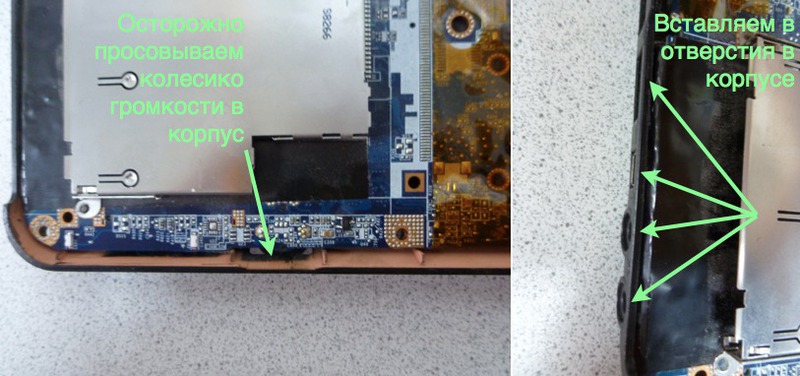
Carefully hide the monitor cable deep into the right of the left speaker and connect to the corresponding connector. The arrows indicate where to connect the cable:
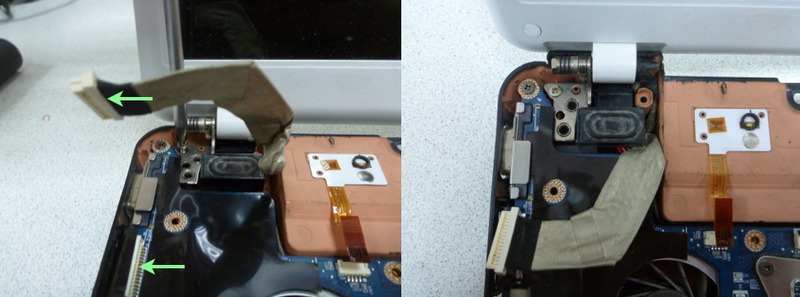
With the fastening of the cable connectors and just wires, we work very carefully and “sensually”. Gently holding both parts, we slowly apply an insertion force until a characteristic soft click is felt. Depending on the connector, it can be very soft and not very snapping, but you can feel it, in my opinion. No need to exert much force, it can damage the soldering of the connector or something worse.
It is convenient to disconnect the loops with our home-made wooden "chisel". Its form is a tribute to your ingenuity and love of comfort. It is usually convenient that it is about 5-10 mm wide with sharp enough sharpening so that it can be inserted into a narrow slot. Also, a wooden stick will not close the contacts when you accidentally touch it on the board.
The screws to be installed in the next step are shown by red arrows. Next, we connect the power button cables with the LED, as well as the network card to the motherboard:
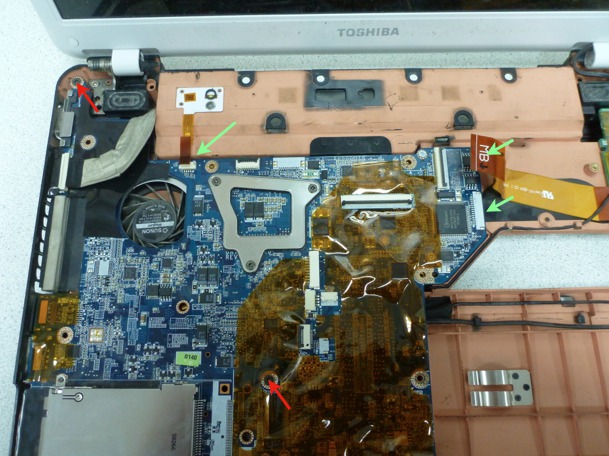
These two cables do not have a plastic connector on the end, instead there is a tab for easy removal. The tongue and cable pressed together form a rigid enough structure to gently insert into the connector on the motherboard. With a fairly slow and accurate application of force, you can feel that the train has entered to the end. You can evaluate this by attaching the end of the loop to the connector before inserting and figuring out the length to which it should go. Also, with some skill, you can gently try to use only the tongue in order to insert the end of the loop into place.
When we see when disassembling that there are many holes for the screws, and only a part of them are busy at this stage, it is better not to be too lazy and at least write down or sketch, and it is better to take a picture of this moment. Remembering such things can be difficult. For example, the photo above shows that of all the holes at this stage, only two screws are required. The remaining openings are for through use with the top and / or bottom cover.
Now it's time to connect the expansion cards on the other side of the motherboard. Do not forget to connect the connectors of the power wires, the battery board and the wi-fi antenna going to the monitor.
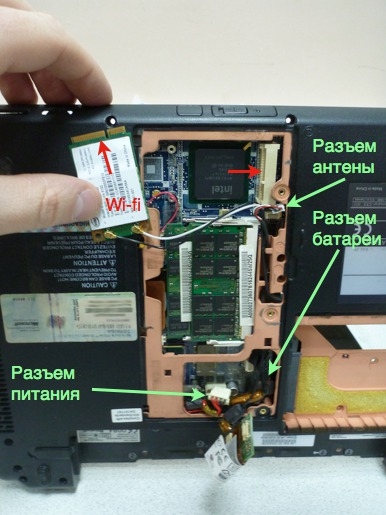
We insert the Wi-Fi card into the proper place in the mini PCI-E slot. We monitor the cleanliness of contacts before this. We do not touch the metal plates of the contact with our fingers. The card is fixed with two screws.
We do the same with the modem. Its connector is vertical. Gently press it until a distinctive soft click is heard. It’s best to do it slowly to feel that the connector is completely in place. We also fix the corresponding screw from our “ticket office”:

Now we put the optical drive in place. Its form also leaves no doubt about the correctness / incorrectness of the placement. We insert the connector in the same way as we did with the network card, without touching the contacts. The drive into the connector should be pushed in the direction from right to left, if you look at the open laptop in a natural way. Fasten it with a screw from the back cover.
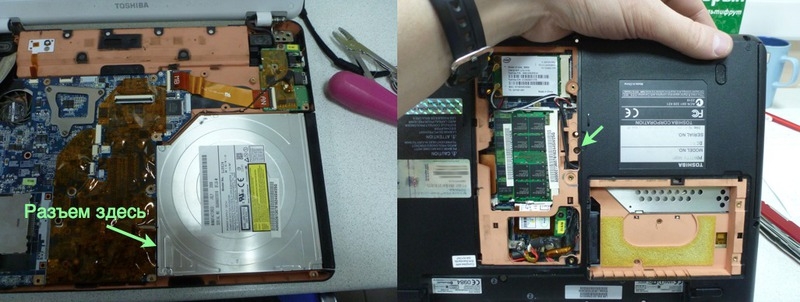
The next step in the assembly will be the connection and fastening of the top cover:
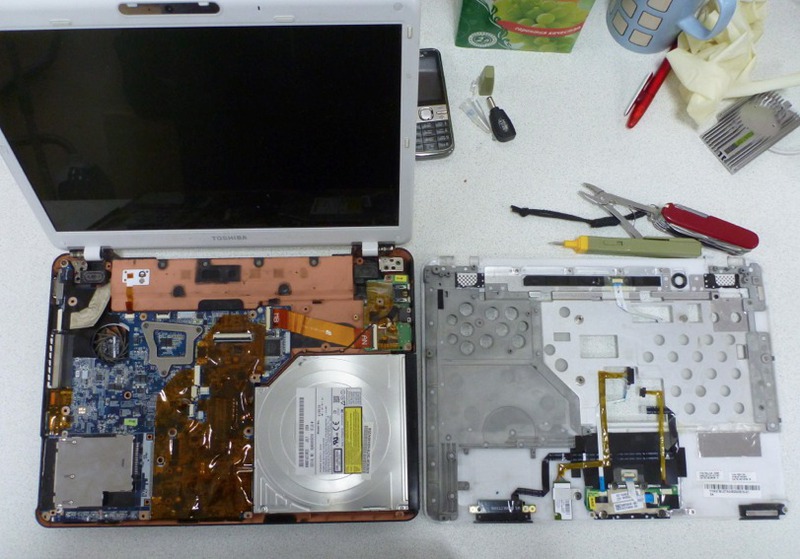
I would like to immediately draw attention to the fact that the operation of removing this cover, in my opinion, is the most potentially dangerous for both breakdown and damage to the appearance of the device. There are two things to keep in mind when disassembling.
Во первых — после того, как вы открутили все мыслимые и немыслимые винты, удерживающие, по вашему мнению, крышку, нужно найти, где находятся пластиковые защелки, которые могут (и, скорее всего, будут) удерживать ее помимо винтов. Поломки тут может быть две — либо неаккуратное поддевание крышки чем-нибудь твердым и плоским, оставляющее неприятные следы “вскрытия” пациента в областях стыковки нижней и верхней крышек, либо можно отломить защелку, что может привести к тому, что стык будет неплотным, в нем образуются щели. Поэтому, я рекомендую для поддевания исопользовать плоский инструмент из материала заведомо более мягкого, чем материал крышек. Это может быть одноразовая китайская палочка, обструганная ножом с широкого конца до состояния стамески, либо аналогичная деталь из мягкого пластика. Такой “инструмент” я советую делать вручную, так как по причине мягкости хватает его ненадолго, после чего надо перезатачивать. Однако, это плата за эстетическое удовольствие от стыка в корпусе после сборки (если таковое изначально имело место быть). После того, как осталась одна сторона крышки, которая держится только на защелках, полезно покачать крышку вверх-вниз, тем самым аккуратно освободив ее от их захвата. В этот момент главное — не спешить, потому что он один из самых “травмоопасных” для починяемого.
Secondly, from the cover to the motherboard, as a rule, there are loops, the connectors of which can be located approximately in the center of the motherboard. It is quite easy to damage them in various parts. Therefore, after the cover has succumbed, carefully look under it, find out how and how it is connected to the motherboard to disconnect it carefully, without leading the cables to critical deformation when lifting the cover.
In this case, the cables to the motherboard are quite accessible without lifting the cover.
By the way, Toshiba carefully indicated the labeling of the screws for convenience. The presence of such marking (F number ) on an empty thread also indicates that a screw should be tightened on this assembly layer.

Among the cable loops there are connectors with a folding plastic clamp strip:
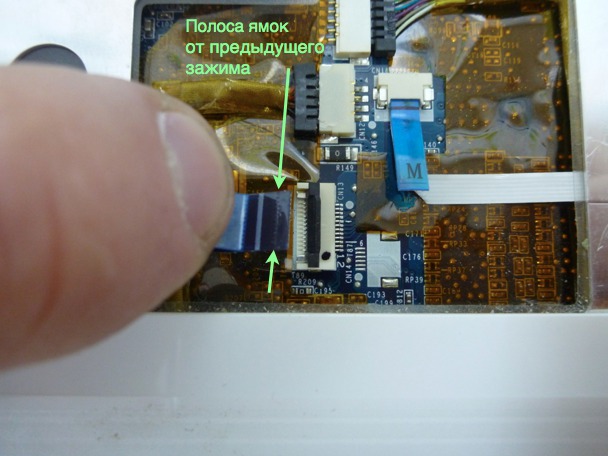
We fold it for installation, set the end of the loop clearly into a shallow indentation for it (fix it in the transverse direction), and then stick it in about the dimples in the loop from the previous clamp. Close the plank. A properly clamped loop should hold rather tightly. If it is removable, then you need to carefully and correctly place the cable again in the recess for it and deepen it into the connector until it clicks into place. Patience and accuracy when connecting loops will pay off when you do not need to disassemble a fully assembled device again, because part of the equipment on board will not work (in this case, the touchpad or lights on the case, or buttons for the player above the keyboard, for example).
The keyboard is convenient to put, leaning back on yourself. Then the loop will be easy to connect. Its connector is also equipped with a folding bar:
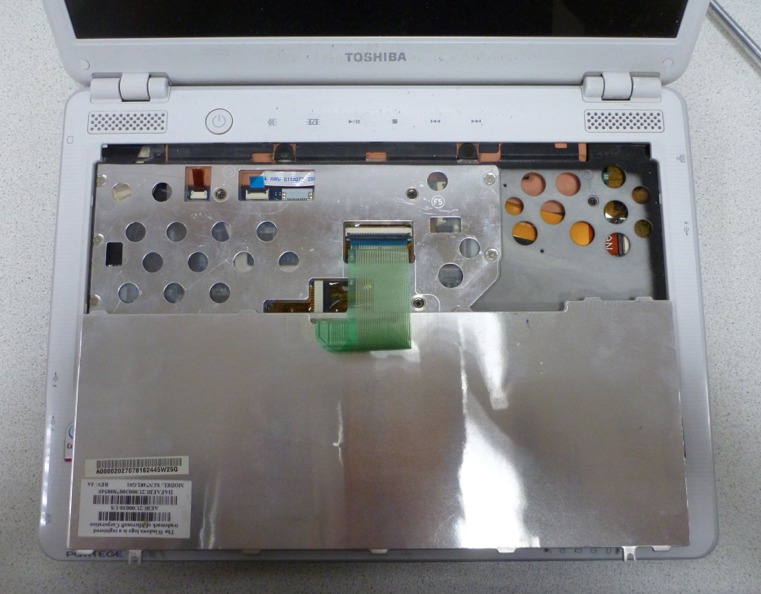
The keyboard is often fastened with latches on the sides. In our case, they are bottom and top (bottom ones are marked with arrows). There are still two screws on top (above the between-buttons F1-F2 and END-INS). The place above the keyboard is closed with a white plastic strip, which simply snaps into place.
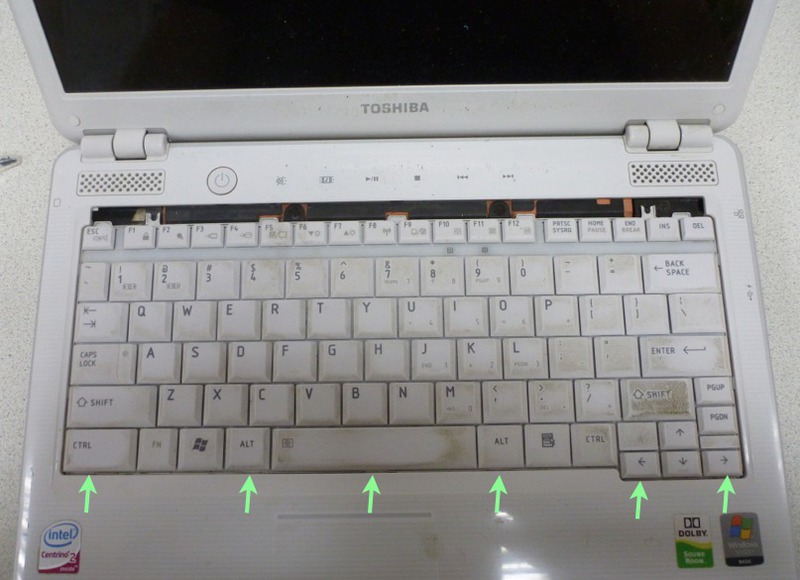
After clicking the plastic strip over the keyboard, the top of the case is ready.
Now back to the bottom cover. Install the screws as in the photo:

Put the hard drive in place. As always, carefully and gently (and most importantly - to the end) we combine the connectors. The screws to fix the disk case do not need to be screwed in yet.
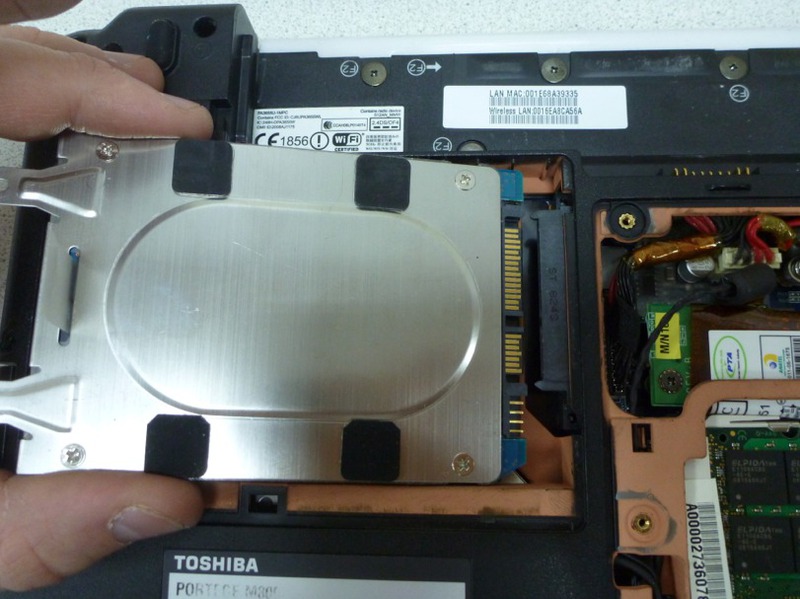
The line of remaining rear cover screws. The screws of the hard drive bay cover fix the drive itself in the body of the laptop. Finally, we close and tighten the three screws of the central memory compartment, modem and network card.
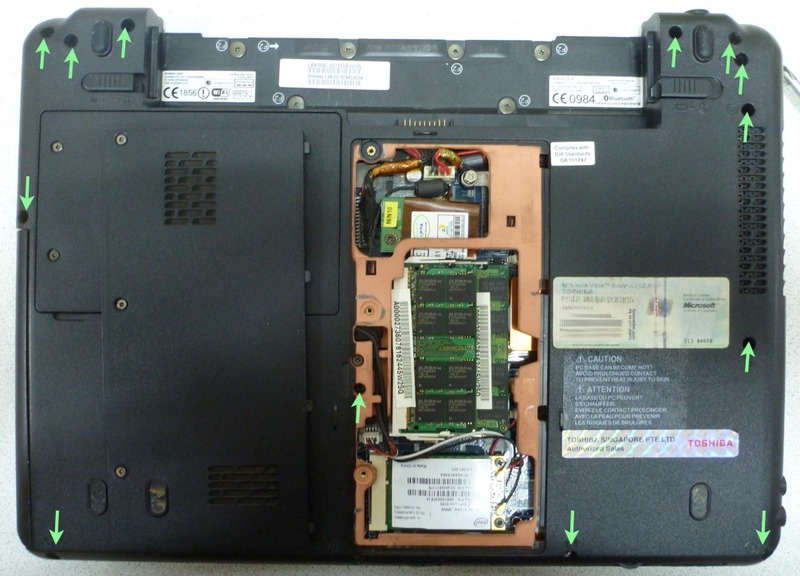
It remains to install the battery,remove the bandages and check the performance!
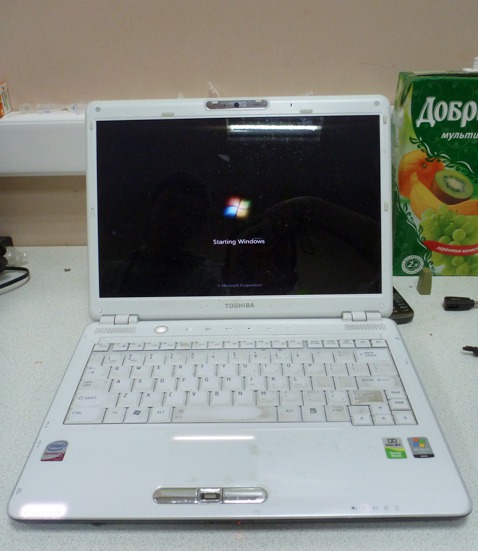
After everything has successfully loaded and there will be no visible problems, it’s good to get into the device manager in Windows or in lspci and its ilk in Linux or in the system information in Mac to make sure that the peripherals are successfully recognized and working. After successfully passing the test, you can finally exhale, relax and enjoy the integrity of the device, which was just distributedevenly on the table and boxes, and now breathes life.
Good luck!
Caution, traffic (24 photos).
First, I want to note that any practical use of this article is entirely at your own peril and risk!Remember, it’s better to ask or google (and sometimes just think longer) than try to do something that you don’t understand.
It was necessary to disassemble the laptop in order to find a place of bad contact in the power circuit. To do this, a wire harness with a connector for connecting an adapter that goes to the motherboard was extracted (for studying, pinching contacts and, if necessary, soldering in a problem place) It is difficult to name a component, for the sake of which it would be necessary to disassemble the laptop in more detail:


For this repair, we need a Philips screwdriver (Phillips screwdriver) (carefully select the size of the screws) and a wooden or plastic strip, which is not a pity to periodically grind to the state of a chisel. A good option is a disposable Chinese chopstick. It will be almost a consumable.
When disassembling, I recommend the use of small lockable containers for screws with signatures, which clearly allow you to restore their purpose and location during assembly. Locked, because it is likely that after disassembling something will distract from the process, and it will be necessary to assemble and pack the disassembled device until

First of all, install the connector in the case and carefully lay the wiring harness as shown in the photo. Incorrectly inserting the connector itself is almost impossible - its shape is quite unique. After installation, we fix the screw grounding to the case with an orange conductive coating.

Now we put in place the left speaker and fasten it with two carefully kept screws.
The screws must be tightened to a reasonable point. Too tightly done, “forever” is not worth it - you can spoil the aesthetics of the screw slot, as well as deform the plastic. In addition, this will make the

We pass to the right loop of the monitor. Carefully lay the wire of the Wi-Fi antenna into the depths to the right of the right speaker, put the loops of the monitor in place and fix them with the corresponding screws.

The hinges are usually quite tight, so it’s best to straighten both at once and screw them together, putting the monitor body in the most convenient position.
Types of motherboard bottom and top, respectively:


When working with circuit boards, it is extremely important to exercise caution with static electricity. Regularly align your potential and the potential of the earth on the board (by touching the metal case of the connector on the side of the board, for example). This is especially true when using woolen clothing and / or concentrated fidgeting on a chair, without which it will be difficult to do. Ideally, it is good to use an antistatic bracelet.
We install the motherboard in its place (it is also quite difficult to put it wrong). Do not forget to be careful when its connectors or other parts abut against the laptop case. If excessive force is applied, the contact of these parts with the board may break. Not useful board and bending strain.

Carefully hide the monitor cable deep into the right of the left speaker and connect to the corresponding connector. The arrows indicate where to connect the cable:

With the fastening of the cable connectors and just wires, we work very carefully and “sensually”. Gently holding both parts, we slowly apply an insertion force until a characteristic soft click is felt. Depending on the connector, it can be very soft and not very snapping, but you can feel it, in my opinion. No need to exert much force, it can damage the soldering of the connector or something worse.
It is convenient to disconnect the loops with our home-made wooden "chisel". Its form is a tribute to your ingenuity and love of comfort. It is usually convenient that it is about 5-10 mm wide with sharp enough sharpening so that it can be inserted into a narrow slot. Also, a wooden stick will not close the contacts when you accidentally touch it on the board.
The screws to be installed in the next step are shown by red arrows. Next, we connect the power button cables with the LED, as well as the network card to the motherboard:

These two cables do not have a plastic connector on the end, instead there is a tab for easy removal. The tongue and cable pressed together form a rigid enough structure to gently insert into the connector on the motherboard. With a fairly slow and accurate application of force, you can feel that the train has entered to the end. You can evaluate this by attaching the end of the loop to the connector before inserting and figuring out the length to which it should go. Also, with some skill, you can gently try to use only the tongue in order to insert the end of the loop into place.
When we see when disassembling that there are many holes for the screws, and only a part of them are busy at this stage, it is better not to be too lazy and at least write down or sketch, and it is better to take a picture of this moment. Remembering such things can be difficult. For example, the photo above shows that of all the holes at this stage, only two screws are required. The remaining openings are for through use with the top and / or bottom cover.
Now it's time to connect the expansion cards on the other side of the motherboard. Do not forget to connect the connectors of the power wires, the battery board and the wi-fi antenna going to the monitor.

We insert the Wi-Fi card into the proper place in the mini PCI-E slot. We monitor the cleanliness of contacts before this. We do not touch the metal plates of the contact with our fingers. The card is fixed with two screws.
We do the same with the modem. Its connector is vertical. Gently press it until a distinctive soft click is heard. It’s best to do it slowly to feel that the connector is completely in place. We also fix the corresponding screw from our “ticket office”:

Now we put the optical drive in place. Its form also leaves no doubt about the correctness / incorrectness of the placement. We insert the connector in the same way as we did with the network card, without touching the contacts. The drive into the connector should be pushed in the direction from right to left, if you look at the open laptop in a natural way. Fasten it with a screw from the back cover.

The next step in the assembly will be the connection and fastening of the top cover:

I would like to immediately draw attention to the fact that the operation of removing this cover, in my opinion, is the most potentially dangerous for both breakdown and damage to the appearance of the device. There are two things to keep in mind when disassembling.
Во первых — после того, как вы открутили все мыслимые и немыслимые винты, удерживающие, по вашему мнению, крышку, нужно найти, где находятся пластиковые защелки, которые могут (и, скорее всего, будут) удерживать ее помимо винтов. Поломки тут может быть две — либо неаккуратное поддевание крышки чем-нибудь твердым и плоским, оставляющее неприятные следы “вскрытия” пациента в областях стыковки нижней и верхней крышек, либо можно отломить защелку, что может привести к тому, что стык будет неплотным, в нем образуются щели. Поэтому, я рекомендую для поддевания исопользовать плоский инструмент из материала заведомо более мягкого, чем материал крышек. Это может быть одноразовая китайская палочка, обструганная ножом с широкого конца до состояния стамески, либо аналогичная деталь из мягкого пластика. Такой “инструмент” я советую делать вручную, так как по причине мягкости хватает его ненадолго, после чего надо перезатачивать. Однако, это плата за эстетическое удовольствие от стыка в корпусе после сборки (если таковое изначально имело место быть). После того, как осталась одна сторона крышки, которая держится только на защелках, полезно покачать крышку вверх-вниз, тем самым аккуратно освободив ее от их захвата. В этот момент главное — не спешить, потому что он один из самых “травмоопасных” для починяемого.
Secondly, from the cover to the motherboard, as a rule, there are loops, the connectors of which can be located approximately in the center of the motherboard. It is quite easy to damage them in various parts. Therefore, after the cover has succumbed, carefully look under it, find out how and how it is connected to the motherboard to disconnect it carefully, without leading the cables to critical deformation when lifting the cover.
In this case, the cables to the motherboard are quite accessible without lifting the cover.
By the way, Toshiba carefully indicated the labeling of the screws for convenience. The presence of such marking (F number ) on an empty thread also indicates that a screw should be tightened on this assembly layer.

Among the cable loops there are connectors with a folding plastic clamp strip:

We fold it for installation, set the end of the loop clearly into a shallow indentation for it (fix it in the transverse direction), and then stick it in about the dimples in the loop from the previous clamp. Close the plank. A properly clamped loop should hold rather tightly. If it is removable, then you need to carefully and correctly place the cable again in the recess for it and deepen it into the connector until it clicks into place. Patience and accuracy when connecting loops will pay off when you do not need to disassemble a fully assembled device again, because part of the equipment on board will not work (in this case, the touchpad or lights on the case, or buttons for the player above the keyboard, for example).
The keyboard is convenient to put, leaning back on yourself. Then the loop will be easy to connect. Its connector is also equipped with a folding bar:

The keyboard is often fastened with latches on the sides. In our case, they are bottom and top (bottom ones are marked with arrows). There are still two screws on top (above the between-buttons F1-F2 and END-INS). The place above the keyboard is closed with a white plastic strip, which simply snaps into place.

After clicking the plastic strip over the keyboard, the top of the case is ready.
Now back to the bottom cover. Install the screws as in the photo:

Put the hard drive in place. As always, carefully and gently (and most importantly - to the end) we combine the connectors. The screws to fix the disk case do not need to be screwed in yet.

The line of remaining rear cover screws. The screws of the hard drive bay cover fix the drive itself in the body of the laptop. Finally, we close and tighten the three screws of the central memory compartment, modem and network card.

It remains to install the battery,

After everything has successfully loaded and there will be no visible problems, it’s good to get into the device manager in Windows or in lspci and its ilk in Linux or in the system information in Mac to make sure that the peripherals are successfully recognized and working. After successfully passing the test, you can finally exhale, relax and enjoy the integrity of the device, which was just distributed
In summary, I will give a set of tips
- If possible, carry out work on a clean, flat surface, without small abrasive particles. Elosion on the table is inevitable, so the patient's body may be scratched. From an uneven surface, small parts will constantly strive to run down.
- Carefully treat the screws, pack them in reliable containers so that you can quickly pack the [semi] disassembled device until better assembly times. The probability of procrastination is quite high, and in my opinion, this is a good habit.
- Be careful about documenting the disassembly process. Best of all, take a picture. If you don’t take a picture, then write, sketch. The specifics of the repair is that we return to the assembly, sometimes much later than planned. Something distracted or lacked moral strength at the moment - everything should be ready to resume repair after a time >> time, when you still remember the order of screwing and the purpose of the screws even less. Not conspicuous moments, such as a poorly visible disconnected loop, write / mark especially.
- When working with the separation of plastic parts, give up the temptation to use a screwdriver for a flat slot or knife. Use dielectric (if electronics are nearby) tools that are softer than separable parts. The same applies to the disconnection of thin metal compounds, where it is important to maintain an intact appearance. A chopped-off disposable Chinese chopstick is a great candidate.
- Be aware of electrostatic hazards. Do not touch the circuit board parts with metal objects (such as tweezers) and do not bring them near. It is better not to use metal tools at all except a screwdriver. Regularly touch with your hand and a screwdriver a safe massive metal part of the device, such as the connector housing, to align potentials. Or use an antistatic wristband.
- Be gentle, affectionate and attentive with connectors. Remember the “science of contacts”. In my opinion, a huge number of problems can be avoided by being careful to connect the connectors.
- Try to understand the purpose of this or that loop, to follow where it goes, what connects. Pay special attention if, in your opinion, something looks illogical. Do not wave at such a moment. This is your chance to upgrade the level of understanding, the ability to understand, and with them the general experience, so necessary in solving more complex problems.
- In my opinion, patience, desire and a reasonable approach can work miracles in the matter of repair, even if experience has not been accumulated at all. Do not be afraid to explore an unknown problem. With a neat and patient approach, you can stop in time, faced with an unknown / insoluble problem and take reversible (accuracy is needed for this) steps in the reverse order, at least when you get to where you started.
Good luck!
